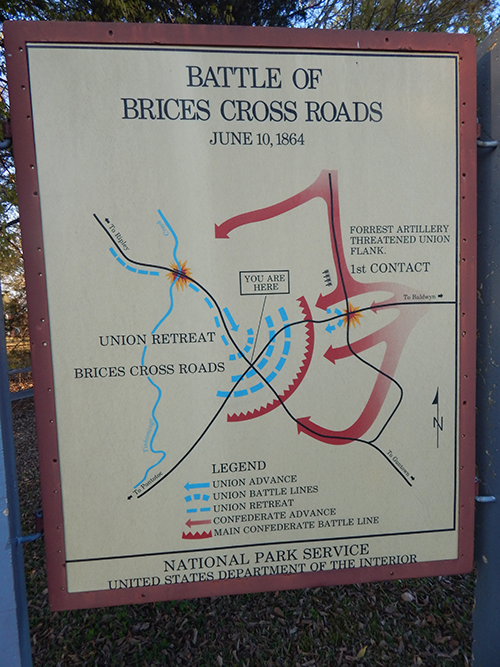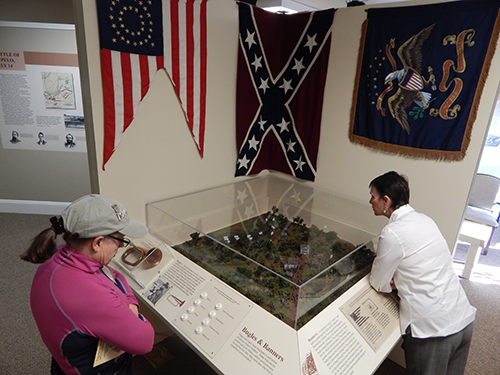Cavalry Raid at Brice’s Crossroads
Cavalry Raid is Only Federal Bright Spot at Brice’s Crossroads

In the spring of 1864 General Nathan Bedford Forrest ranged freely in north Mississippi and western Tennessee. His Confederate cavalry attacked Union garrisons, disrupted communications, raided supply trains and generally impeded General William Tecumseh Sherman’s plans to advance on Georgia. Forrest also was recruiting and strengthening his force.
In June, Sherman dispatched Brigadier Samuel D. Sturgis from Memphis with a mission to subdue Forrest. In his command was Colonel Joseph Kargé who led a cavalry brigade including his Second New Jersey regiment and the Tenth Missouri. Kargé was originally from Poland and had served as a cavalry officer in the Prussian army before coming to America. When the Civil War began, he helped raise the First New Jersey Cavalry.

Upon entering Mississippi with the Sturgis expedition, Kargé was given a raiding and reconnaissance mission: disrupt and destroy railroad operations, wreck the trestles at Rienzi, obtain Confederate telegraph transmissions on their movements and troop strength. He proceeded with 400 handpicked men.
They arrived at Rienzi on the morning of 7 June, burned the depot and destroyed the railroad yard. At one point his detail was surrounded by two of Forrest’s brigades but escaped. When pressed, they had moved onto an island in the Hatchie River guided by a local citizen pressed into service under penalty of death. The next morning they found an unguarded gap in the Confederate lines and Kargé swam his cavalry across the river. Once safe, they rejoined the main body of the expedition near Ripley with mission accomplished. Earlier Sturgis declared the expedition hopeless and even admitted in his official report that he had doubts about continuing because of heavy rains, bad road conditions, tired horses and a Confederate force vastly overestimated at almost 20,000. Sturgis dreaded defeat and in conferencing with his officers—before the return of Kargé—they concurred that the end result would probably be disaster. Had Kargé been present his success may have bolstered their confidence. Nevertheless, Sturgis and his officers pressed on, agreeing that it would be disgraceful to return to Memphis without confronting the enemy. Sentiment in the Union camp was that Sturgis’ expectation of defeat could only have a negative bearing on the results.
Forrest planned a furious attack on 10 June at Brice’s Crossroads so the Yankees would not know how few Confederates they faced. His first strike was to “whip” the Union cavalry riding three hours ahead of the foot soldiers. He predicted that when shooting started the Federal infantry would rush to the front double-time. The June heat would exhaust them and his cavalry would “blow right over them.” A frontal assault combined with charges on both flanks panicked the northern troops. The retreat became disorganized flight compounded by a logjam of men, wagons and artillery attempting to cross Tishomingo Creek.
 The Indiana Herald told of Union troops fighting repeated attacks then retreating 25 miles after burning most of their supply train and destroying ten artillery pieces to keep them from Rebel hands. The “disaster” warranted a military board of investigation in which Sturgis confirmed Kargé’s reconnaissance mission with “400 select cavalry.” He also attributed some of the difficulties and loss of contact with his superiors to having sent his telegraph operator with Kargé to help intercept Confederate communications. The operator, Fred W. Snell, wrote an 1882 retrospective in the Chicago Daily Tribune charging that the conduct and failure of the expedition was a “crime” unparalleled and “had General Sturgis been a Confederate officer in disguise, he could not have more successfully turned over to the Rebels” 3,000 veteran troops and a huge supply train.
The Indiana Herald told of Union troops fighting repeated attacks then retreating 25 miles after burning most of their supply train and destroying ten artillery pieces to keep them from Rebel hands. The “disaster” warranted a military board of investigation in which Sturgis confirmed Kargé’s reconnaissance mission with “400 select cavalry.” He also attributed some of the difficulties and loss of contact with his superiors to having sent his telegraph operator with Kargé to help intercept Confederate communications. The operator, Fred W. Snell, wrote an 1882 retrospective in the Chicago Daily Tribune charging that the conduct and failure of the expedition was a “crime” unparalleled and “had General Sturgis been a Confederate officer in disguise, he could not have more successfully turned over to the Rebels” 3,000 veteran troops and a huge supply train.
Brice’s Crossroads was a setback for the Union in Mississippi, but Kargé’s cavalry missions and defensive work were the bright spots in the otherwise failed expedition. Forrest achieved victory with only 492 casualties to his available force of 3,500 men against what he reported as 10,252 opposing him on the Union side. He felt his victory complete and cited Union killed and wounded of more than 2,000 plus another 1,618 captured as well as a complement of artillery pieces and a wagon train of supplies and ammunition. General Sturgis remained without assignment for the duration of the war and Joseph Kargé emerged with a more lustrous reputation as a tactical cavalryman. Sturgis himself singled out the colonel despite the debacle and declared him an “excellent and dashing officer.” He cited Kargé’s raid and reconnaissance, and his subsequent management of the rear guard during the retreat, fighting and defending to keep the rout from becoming a slaughter.


